This scientific and technological competition related to the future of mankind has now entered the “racing competition” stage.

Image source: Generated by Unbounded AI
Just as 2025 kicked off, China has set off an unprecedented wave in the field of AI.
DeepSeek has sprung up, sweeping the global market with its low-cost + open source advantages, achieving dual-end top rankings in iOS and Google App Store. Data from Sensor Tower shows that as of January 31, DeepSeek’s daily active users have reached 40% of ChatGPT, and it continues to expand at a rate of nearly 5 million new downloads per day. It is known by the industry as a mysterious force from the East.
Faced with the onslaught of DeepSeek, Silicon Valley has not yet reached a consensus.
Karp, CEO of AI big data company Palantir, said in an interview that the rise of competitors such as DeepSeek shows that the United States needs to accelerate the development of advanced artificial intelligence. Ultraman mentioned in an interview with Radio www.gushiio.coms that although DeepSeek has done a good job in terms of products and prices, he was not surprised by its appearance. Musk has repeatedly said that he has no revolutionary breakthroughs, and soon a team will release a better performance model.
On February 9, Weicao Zhiku, the Information Society 50 Forum, and Tencent Technology jointly sponsored the live broadcast of the AGI Road series “Talk about DeepSeek’s Achievements and the Future of AGI” online seminar, inviting economists and Hengqin Digital Chain Zhu Jiaming, Chairman of the Academic Committee of the Institute of Finance, Chairman of the Supervisory Committee of the China Automation Society and Researcher of the Institute of Automation, China Academy of Sciences, and He Baohui, founder of EmojiDAO, to share themes on how to replicate the AGI development route. The decentralization of the next DeepSeek model was shared.
Professor Zhu Jiaming is extremely optimistic about the development speed of AI. He said that the cycle of technological progress in primitive society is 100,000 years, agricultural society is 100 years, industrial society is 100 years, and the Internet era is basically 10 years. In the era of artificial intelligence, its speed is even more unimaginably accelerating. Artificial intelligence will move towards AGI or ASI from now on, which will take 2-3 years not conservatively, and 5-6 years more conservatively. rdquo;
In Professor Zhu Jiaming’s view, the future development of artificial intelligence will diverge: one is a more cutting-edge, cutting-edge, and high-cost route aimed at studying unknown fields to mankind; the other is to move towards low-cost, large-scale popularization route. When artificial intelligence develops into a new stage, there will always be two routes, one is from 0 to 1 in the new stage, and the other is from 1 to 10. rdquo;
Professor Wang Feiyue integrated the development of AI technology at home and abroad and emphasized that DeepSeek’s achievements today have reshaped China’s confidence in investing and leading artificial intelligence technology and industry. He believes that OpenAI will not share super intelligence, but will only force other companies to a dead end.
Regarding how to incubate more teams like DeepSeek, Wang Feiyue cited the birth cases of AlphaGo and ChatGPT to emphasize the value of DeSci’s decentralized scientific research model.(We) cannot rely entirely on planning and the national system to develop artificial intelligence technology.& rdquo;
Regarding DeepSeek’s large-scale use of data distillation technology, there are many critical voices in the industry, even comparing distillation to theft. Wang Feiyue said that he wanted to name knowledge distillation. He said that knowledge distillation is essentially a transformation of a form of education. Just because people’s knowledge comes from teachers, they cannot think that they cannot surpass teachers. rdquo;
He Baohui, like Wang Feiyue, values the value of decentralization. In his view, decentralization is a cost-reduction path for deep learning models and the key to computing power, network and data security.
“Decentralized computing power networks and data storage, such as Filecoin, have much lower storage costs than traditional cloud services (such as AWS), significantly reducing costs. rdquo; He Baohui said that a decentralized management mechanism (can) ensure that no one can unilaterally change these networks and data. rdquo;
For the Agent after the big model, He Baohui regards it as a kind of life. I think it is not just a tool, but also a kind of life. Just because we create AI does not mean that we completely dominate it.” rdquo;, He Baohui said, I am very concerned about how to enable Agents to achieve eternal life and exist independently in a decentralized network and become a brand new species.” rdquo;
The following are the highlights of the live broadcast sharing record (with deletions and adjustments without changing the original intention):
Zhu jiaming
the development of artificial intelligence
There are only two ways from 0 to 1 and 1 to 10
The topic I want to talk about today is the evolutionary scale and large model of artificial intelligence, and the subtitle is the analysis of DeepSeek V3 and R1 series of phenomena.
It mainly focuses on five issues: the time scale of artificial intelligence evolution, the artificial intelligence ecosystem, how to comprehensively and objectively evaluate DeepSeek, the global response triggered by DeepSeek, and the outlook for artificial intelligence trends in 2025.
First of all, the actual evolution time scale of artificial intelligence is much faster than expected by experts, including scientists in the field of artificial intelligence.
In the long history of mankind, we have experienced farming society, industrial society, and information society, and now we have entered the era of artificial intelligence. In this historical process, the time period for technological evolution has been shortening.
The cycle of technological progress in primitive society is in a unit of 100,000 years; the agricultural society is in a unit of thousands of years; the cycle of technological progress in industrial society is as long as 100 years and as short as 10 years; in the Internet era, it is in a unit of 30 – 10 years; in the era of artificial intelligence, its speed is even more unimaginably accelerating.
Before the emergence of GPT-3, people expected that it would take about 80 years for artificial intelligence to reach the AGI era; after the emergence of GPT-3, people shortened this expectation to 50 years; when LLaMda2 appeared, everyone’s expectations changed again. 18 years.
In 2025, people’s expectations for achieving AGI may be shorter, conservatively speaking, 5-6 years, and optimistically speaking, 5-6 years.
Comparing the figure below, we can clearly see that artificial intelligence has obvious acceleration characteristics compared with any technological revolution or technological innovation in human history.
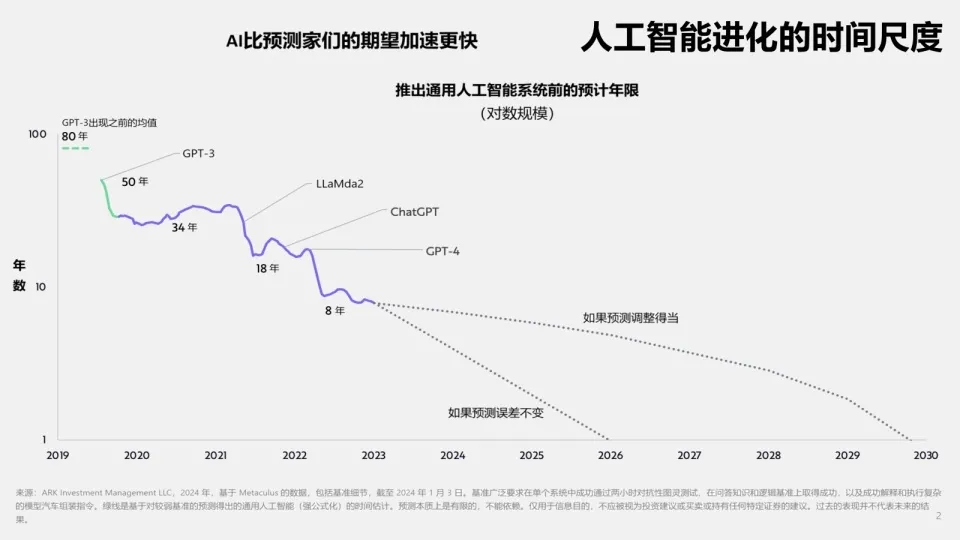
If we use the first speed, second speed, and third speed of the universe to describe the current rapid development of artificial intelligence. At present, artificial intelligence has completed the transformation from the first speed of the universe to the second speed of the universe. Artificial intelligence has begun to enter a high degree of autonomy and escape the shackles of humans.
As for what circumstances will we escape the shackles of the sun’s gravity and enter the third velocity of the universe, we don’t know. But what is certain is that artificial intelligence has completed the leap from general artificial intelligence to super artificial intelligence. After 2017, artificial intelligence is undergoing drastic changes and upgrades at the frequency of years, months, and weeks.
Why does artificial intelligence show exponential acceleration and enter the second-speed stage of the universe? I think there are three very important reasons.
● First, as Musk said, by the end of 2024, the data used to train models will be exhausted, and the large model will basically use up human knowledge. Starting from 2025, the bigger goal of the big model is to find incremental data. This is a historic turning point. The big artificial intelligence model has completed the transformation from extensive to intensive;
● Second, the hardware of artificial intelligence continues to evolve;
● Third, artificial intelligence has entered a development stage that relies on artificial intelligence itself to develop itself.
Currently, the large model matrix of companies including OpenAI, DeepMind and Meta has formed an interdependent and mutually reinforcing mechanism. The ecological construction of artificial intelligence follows the law of vertical speed breakthroughs driving horizontal ecological fission. At the horizontal ecological level, the three paradigms of multimodal fusion revolution, accelerated vertical domain penetration, and distributed cognitive networks are reshaping the technological landscape.
In the increasingly mature artificial intelligence ecosystem, spillover effects (generalization effects) naturally occur and basically penetrate into science, economy, society and people’s cognitive levels.
DeepSeek, how can we comprehensively and objectively evaluate DeepSeek for phenomenal products that exploded during the Spring Festival?
First of all, DeepSeek has received continuous attention from domestic and foreign media, and has triggered experiential use by the world’s public, forming a huge shock wave. Public opinion plays a very important role in history. Some events are amplified by public opinion, some events are underestimated by public opinion, and over time, they will eventually return to their original state in history.
DeepSeek V3 mainly has four significant advantages: high performance, efficient training, rapid response, and special adaptation to the Chinese environment. DeepSeek-R1 mainly includes the advantages of strong computing performance, excellent reasoning capabilities, good functional characteristics, and strong scenario applicability.
Of course, DeepSeek still has some issues that need improvement or face challenges. How to improve the accuracy rate? How to solve multimodal output and input problems? The stability of the server in terms of hardware and how to deal with the increasing number of sensitive topics that are unavoidable.
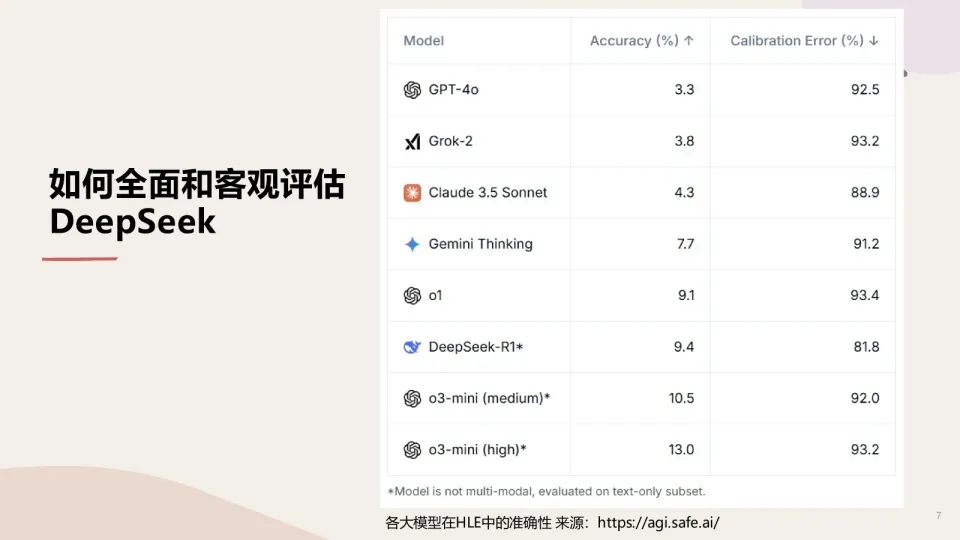
Among these issues, the most worthy of discussion and the one that everyone is most concerned about is the cost of artificial intelligence models, which has a series of fundamental differences from the concept and structure of industrial product costs.
The cost of a large artificial intelligence model lies first and foremost in the infrastructure. The reason why DeepSeek shows its superiority in terms of infrastructure costs is that it uses a large number of relatively low-priced A100 (chips); secondly, it is research and development costs, which involve the cost of algorithm reuse. DeepSeek has certain advantages in this regard; Moreover, attention needs to be paid to data costs, the cost of introducing emerging technologies, and the cost structure in comprehensive computing.
Discussions about cost will also involve the issue of technical routes. There will always be two routes when artificial intelligence develops into a new stage. One is from 0 to 1 in the new stage, and the other is from 1 to 10. At any stage of future development, as long as the route from 0 to 1 is chosen, the cost will inevitably increase; while choosing the route from 1 to 10 may reduce costs by improving efficiency.
“From 0 to 1, DeepSeek has performed well in benchmark tests. In particular, the HLE (Humanity’s Last Exam) standard set compiles 3000 questions designed by more than 500 institutions in 50 countries and regions around the world, covering core competency assessments such as knowledge reserve, logical reasoning, and cross-domain migration.
In the HLE benchmark, DeepSeek achieved an accuracy of 9.4, and the stronger one is OpenAI o3; of course, it far exceeds GPT-4o and Grok-2 in this field, which should be quite a dazzling achievement.
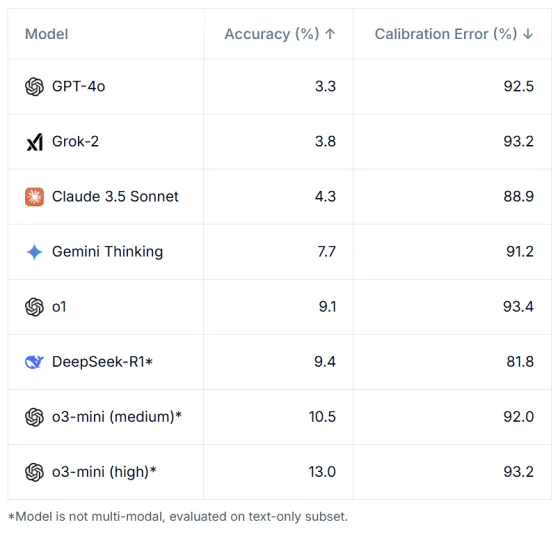
We all know that after the launch of DeepSeek, global artificial intelligence companies including Microsoft, Google, Nvidia, etc. have responded to varying degrees. This means that during the evolution of artificial intelligence, its balance point is constantly being broken. When a new artificial intelligence breakthrough occurs, pressure will be created, which in turn stimulates the entire system to respond; this reaction will lead to new breakthroughs, generate new pressures and form a new balance point.
Now, the cycle of this influence and reaction is shrinking. We will find that artificial intelligence competition is a quite divergent model, providing relatively large development space for innovation and breakthroughs.
In the evolutionary scale of artificial intelligence and the outlook of large-scale model ecology, technological development presents a dynamic cycle pattern of leading challenges and breakthroughs and then leading. This process is not a zero-sum game, but a spiral of the overall ecology through continuous iteration.
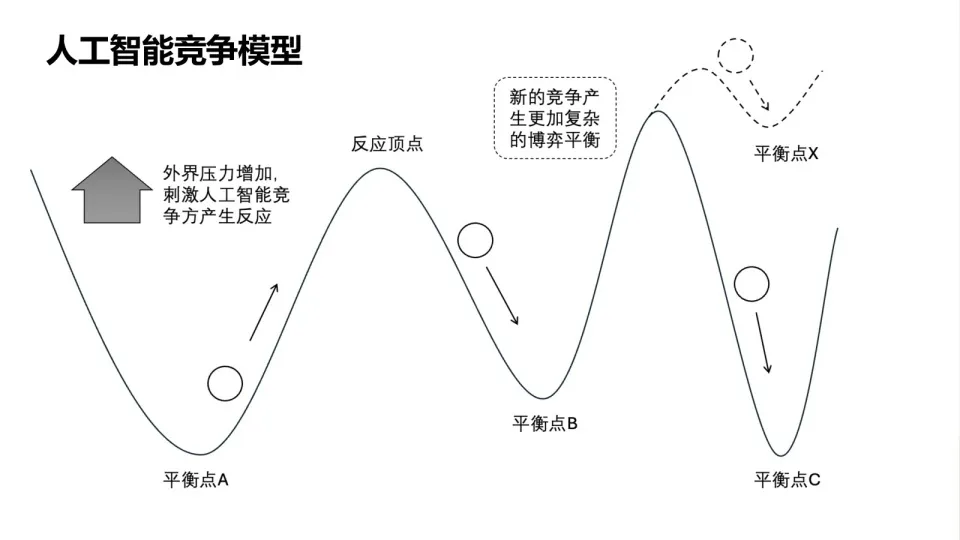
Finally, I would like to talk about the outlook for the development trend of artificial intelligence in 2025.
There are two directions in which artificial intelligence has reached today. One is to professionalize the high-end route, expand the frontier, and explore unknown areas. Another path is the mass popularization route. Such large models have the core goal of lowering the threshold for use and meeting the basic needs of a wide range of users.
Now, mankind has entered a new era. Artificial intelligence is both a microscope and a telescope. It will help us understand the deeper and more complex physical world that even microscopes and telescopes cannot reach at this stage.
In the future, artificial intelligence will inevitably present a diverse and multi-dimensional pattern. Just like Lego bricks, or even like Rubik’s Cube, they are constantly combined and reconstructed to create a new world that exceeds the limitations of our own knowledge and experience.
Further breakthroughs in artificial intelligence require increasing capital investment. Demand for artificial intelligence is rapidly consuming existing data center capacity, prompting companies to build new facilities.
In short, artificial intelligence is moving towards indomitable ground: the sky is to improve the quality of the simulated physical world while constantly exploring unknown areas; indomitable ground is to promote artificial intelligence to reduce costs, implement it in all directions, and benefit the people. In this context, we can see DeepSeek’s advantages, limitations and future potential more objectively and comprehensively.
Wang Feiyue
OpenAI will push other companies into desperate situations
“Copying DeepSeek relies on decentralized scientific research
In a certain sense, DeepSeek is a great social achievement today. Its influence is unmatched by previous technological breakthroughs. Its technological value and commercial value are lower than the economic value it may bring in the future, and lower than its potential impact on society, that is, its impact on today’s international competition landscape and international politics. After OpenAI became ClosedAI, DeepSeek has restored international confidence and hope for open source openness, which is very valuable.
I’m not going to talk about the specific details of this technology because I’ve talked about too much now and I just want to express my feelings here.
I am very happy that China’s international influence in this field has finally achieved a breakthrough of zero, breaking the myth and almost monopoly of OpenAI and forcing it to change its behavior. In particular, OpenAI is no longer Open and will not share its super intelligence with society, especially the international community. Its success will only push other companies, including American companies, to the brink. I still hope that normal technological competition can be maintained among countries and between people rather than technological war.
This is a very great thing at the moment. DeepSeek has given everyone more confidence in China’s scientific and technological progress, especially the development of artificial intelligence.
I believe that the essence of emerging commodities in the era of intellectual industry is trust and attention, and DeepSeek has given us both, reflecting its important value. What the whole society needs to do next is how to turn trust and attention into new goods that can be produced on a large scale and circulated on a large scale, so that an intellectual society can become a reality and transcend agricultural and industrial societies.
Next, I want to justify knowledge distillation.
There are some satirical statements on Social networks about knowledge distillation, such as asking for food from other people’s mouths and fishing in other people’s fish baskets, which is actually a deliberate misinterpretation of knowledge distillation. Knowledge distillation is essentially a deformation of the form of education. Just because people’s knowledge comes from teachers, they cannot believe that they cannot surpass teachers. Of course, large models, from ChatGPT to DeepSeek, must strive to generate or improve their reasoning capabilities, and play less, so that AI for AI can be used to justify knowledge distillation.
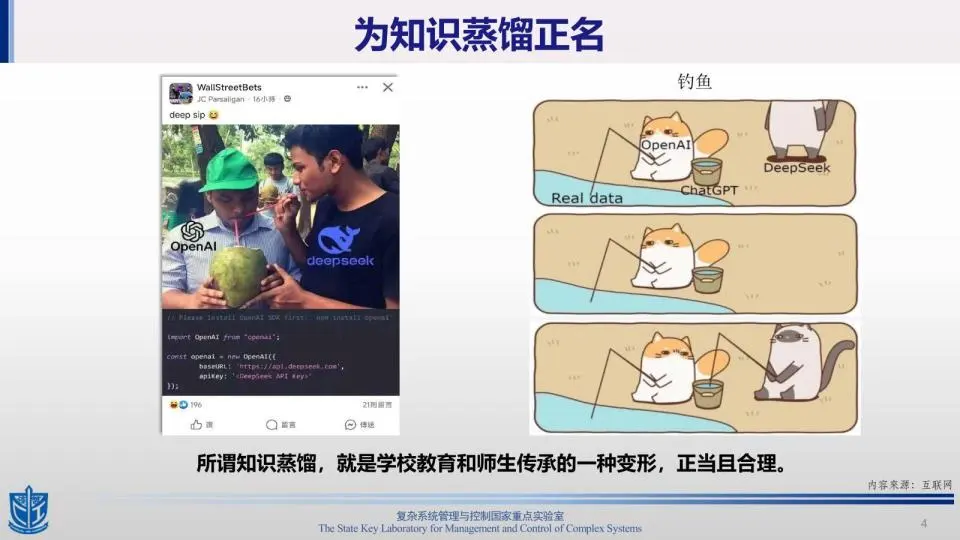
When talking about what to do after DeepSeek, we must first discuss the two scientific and technological development models of decentralized scientific research DeSci and centralized scientific research CeSci. AlphaGo, ChatGPT and DeepSeek are all products of the DeSci model, that is, distributed and decentralized independent scientific research; in contrast, CeSci is a state-led organization planning research.
I think we must face up to the role of DeSci and cannot rely solely on planning or national systems to promote the development of artificial intelligence technology.
Because the foundation of artificial intelligence technology is diversity, as Marvin Minsky, one of the main sponsors of artificial intelligence, said: What incredible secret is it that makes us intelligent? The trick is that there is no trick. The power of intelligence comes from our great diversity, not from any single, perfect principle. rdquo;。
Therefore, excessive strategic planning may restrict the natural development of diversity. Before effective models or technologies emerge, DeSci should be the main focus. After certain real innovations emerge, the state-led CeSci model will be used to further guide technology to accelerate closer to the established goals. We must avoid aerial attic behavior, especially in this era of great intellectual change.
For those of us who have worked in the AI field for a long time, AI today and AI in the past are two worlds.
In the past, AI referred to artificial intelligence, but now it has gradually transformed into agent or agent intelligence. In the future, the meaning of this word may also change to Autonomous Intelligence and become a new AI, especially autonomous organized autonomous intelligence, that is, AI for AI or AI for AS, Autonomous Systems, a new stage in which artificial intelligence promotes the development of artificial intelligence. This is also consistent with what John McCarthy, the founder of artificial intelligence, said: the ultimate goal of artificial intelligence is the automation of intelligence, and actually the automation of knowledge.
Whether it is now or in the future, the three AI types, old, and new, will coexist. I collectively call them parallel intelligence.
I have also publicly stated my position. Although I have pursued explicable artificial intelligence for more than 40 years, I believe that intelligence is inherently unexplainable. I adapted Pascal’s bet that artificial intelligence cannot be explained, but it can be governed and must be governed. Make it simple: there is no need to explain, there must be governance.
I am very happy to see this progress in DeepSeek, but it is still too early to say at present, and there is no need to use general artificial intelligence to scare everyone. Don’t worry too much. In fact, even if you worry, it will help, and development is inevitable.
Scientific researchers must have a pattern and separate internal activities. They must turn SCI into SCE++ Slow ‘s slowness, slow and calm down to do scientific research. Casual’s animation is not based on utilitarian scientific research. Finally, Easy pursues simplicity and simplicity. Elegant must have a quality pattern and Enjoying pursues pleasant and enjoyable scientific and technological work. This is the life that artificial intelligence should bring to us.
He Baohui
Big models should also be decentralized”
I want to see Agent live forever
I am not a professional in the field of AI and have only recently begun to study the history of AI in depth. I mainly focus on my experience in entering the Web3 industry in 2017 to talk about our current work and my views on the changes DeepSeek may bring.
First of all, I want to emphasize a basic issue: there are significant differences between DeepSeek and OpenAI’s underlying models, and it is this difference that really shocked the Western world.
If DeepSeek had just copied Western technology, they would not have felt so shocked, let alone triggered such extensive discussions, and even made all big companies have to take it seriously. What really shocked them was that DeepSeek had traveled a different path.
OpenAI adopts the SFT (Supervised Fine-Tuning) approach, relying on manual annotation of large amounts of data and generating content through probability models. Its innovation lies in accumulating these results through a large amount of manual work and high cost.
A few years ago, AI technology was considered almost impossible to achieve, and the emergence of OpenAI subverted this view and pushed the industry towards the SFT technology path.
DeepSeek uses almost no SFT technology, but uses a cold start method of reinforcement learning to explore unknown paths.
This approach is not new. The first version of Google DeepMind’s AlphaGo relies on a large amount of data to learn, while the second version of AlphaGo Zero relies entirely on rules, and through self-play and exploration of 10,000 chess games, it comes to a better result than the former.
Cold starting with intensive learning is more difficult and training is unstable, so it is less used, but I personally think this may be the real path to AGI, rather than a path that relies solely on data tuning.
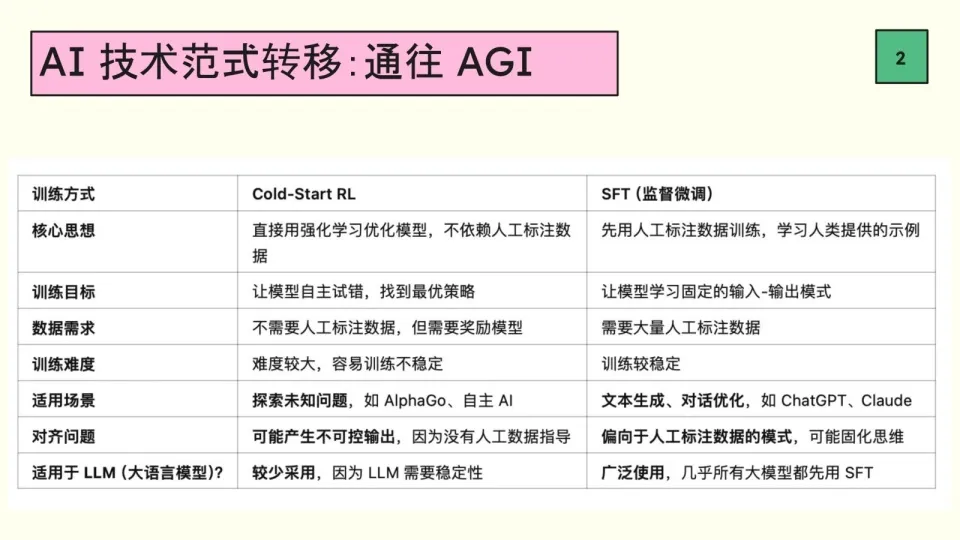
In the past, the data adjustment method was more like big data integration, while DeepSeek really found conclusions through independent thinking. Therefore, I think this marks a paradigm shift in AI technology, from SFT technology to self-reasoning technology.
This transformation brings two core characteristics: open source and low cost.
Open source means that everyone can participate in construction.
In the Internet era, the Western world has always been known for its open source, but the emergence of DeepSeek changed this situation. It was the first time that the East defeated them on the main battlefield of the West.
This open source model has triggered a strong reaction in the industry, with some founders of Silicon Valley companies even criticizing it, but public support for open source is very strong because it makes it available to everyone.
Low cost means that the deployment and training costs of this model are extremely low.
We can fully deploy DeepSeek on personal devices such as MacBooks and complete commercial deployment, which was unimaginable in the past. I believe that AI is moving from the era of decentralized IT led by OpenAI to the era of mobile Internet where flowers bloom.
For AI, there are three major elements that need to be analyzed: big models, computing power, and data.
After the big model ushered in disruptive innovation, the demand for computing power began to decrease.
At present, the supply of computing power has become redundant. Many GPU investors purchase equipment at high prices but cannot obtain the expected returns, and the cost of computing power has gradually declined. Therefore, I don’t think computing power will become a bottleneck.
The next important bottleneck is data.
After U.S. stocks Nvidia’s share price fell, data companies such as Palantir rose sharply, indicating that everyone is beginning to realize the importance of data. Especially with large models open source, anyone can deploy models, and data differentiation will become the focus of competition.
Who can access proprietary data and update it in real time will be the key to competition.
From the perspective of decentralization, the decentralization of computing power and data has become relatively mature. Decentralized computing power networks and data storage, such as Filecoin, have much lower storage costs than traditional cloud services (such as AWS), significantly reducing costs.
At the same time, decentralized management mechanisms ensure that no one can unilaterally change these networks and data. Therefore, deep learning models should also develop in a decentralized direction.
So for DeAI, I think it has two development paths:
● The first is distributed AI (Decentralized/Distributed AI) based on decentralized technical facilities.
● The other is Edge AI, which means that AI runs directly on personal devices. Edge AI can effectively solve data privacy issues and greatly improve real-time performance. For example, autonomous driving technology requires extremely high real-time response, and any delay can have serious consequences. If AI can complete calculations locally, efficiency and experience will be qualitatively improved. Therefore, edge AI will become an important direction for future development, bringing a large number of new application scenarios.
In addition, another advantage of decentralized AI is its ability to support multi-party collaboration. The birth of blockchain and Bitcoin stems from the difficulty of measuring trust between people. A decentralized trust mechanism allows large-scale cooperation to be completed without intermediaries.
In the field of Web3, there is a saying called Code is law, which means code is law. I believe that in the decentralized collaboration of AI, this concept should be transformed into DeAgent is law, that is, autonomous management and legal management are realized through decentralized networks and agents.
I think maybe the purpose of human survival is to train an Agent to completely replace oneself. It can think the same as humans and live in place of human beings after the death of human bodies. Regarding the concept of Agent, I think it is not just a tool, but also a life. Just because we create AI does not mean that we completely dominate it.
When AI has its own ideas, we should let it develop on its own, rather than limit it to a tool. Therefore, we are very concerned about how to enable Agents to achieve immortality and exist independently in a decentralized network and become a brand new species.
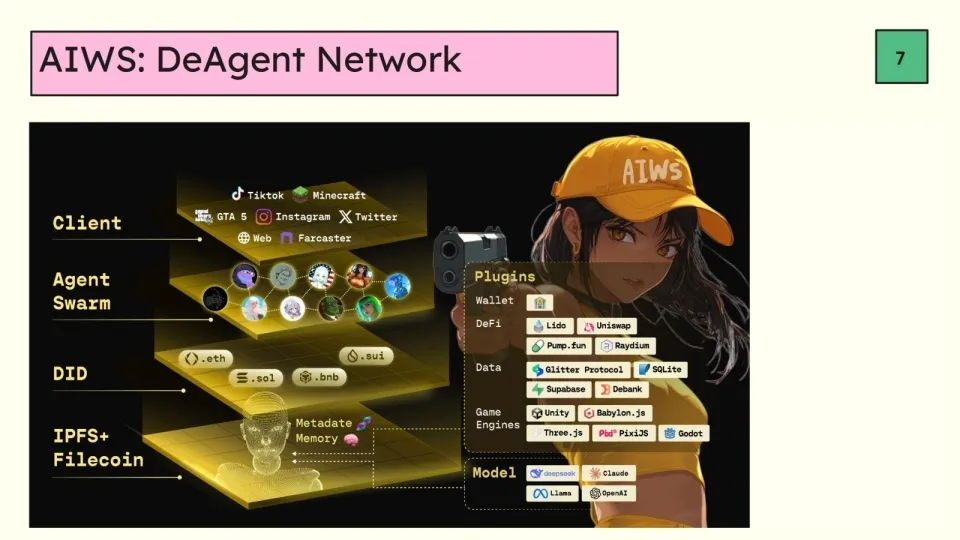
As technology continues to break through, applications gradually deepen, and the era of AI universal benefits is approaching, how to find a balance between innovation and ethics will become an important issue in future development.
conclusion
Humanity enters the AI racing stage
DeepSeek’s breakthrough has drawn an important stroke for mankind, especially China, in exploring the AGI road. Against this background, the voices of encouragement and reflection are worthy of attention. Everyone should hope that it can get better and stronger. However, it will take time to prove whether its technical route can ultimately withstand the test of business and the market.
One point in Wang Feiyue’s sharing is very noteworthy. AlphaGo, ChatGPT and DeepSeek are all products of the DeSci model. We must face up to the role of DeSci and expect more China DeepSeek to stand out in the field of artificial intelligence.
Professor Zhu Jiaming mentioned in his sharing that the speed of progress in the era of artificial intelligence has surpassed any era that mankind has experienced in the past. He said that the AGI era can arrive in as soon as two years. This time may not be accurate, but the general trend is indeed the case, because once new products and technological routes break the existing balance, they will put pressure on the industry as a whole, stimulate the overall response of artificial intelligence, and then form a new round of breakthroughs through reaction.
Products like DeepSeek are the external force that breaks the balance. That’s why we saw that Sam Ultraman announced on X that the GPT-5, which was originally delayed repeatedly, would be made public in a few months.
What is certain is that not only OpenAI, but also Silicon Valley companies such as xAI, Meta, and Google will take action.
This scientific and technological competition related to the future of mankind has now entered the racing stage.
Welcome to join the official social community of Shenchao TechFlow
Telegram subscription group: www.gushiio.com/TechFlowDaily
Official Twitter account: www.gushiio.com/TechFlowPost
Twitter英文账号:https://www.gushiio.com/DeFlow_Intern



